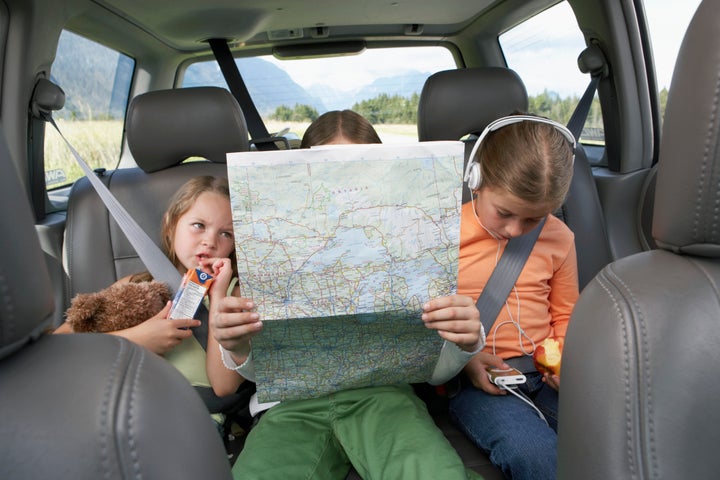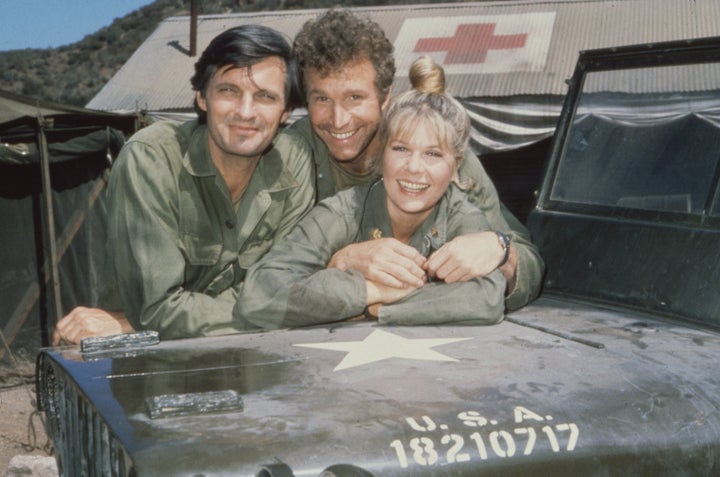There’s no question that the internet has made life easier. But it also has wiped out a lot of personal habits, some of which might have been time-consuming but were also kind of fun.
So if you’re feeling nostalgic, you might enjoy taking a look back at some of the habits and behaviors that have been virtually eliminated by the internet.
1. We rarely use physical maps.

Maybe it’s wrong to call reading a map a habit. It was more of a behavior or an activity, but plenty of people used to read maps. If you’re engaging in cartophilia these days, it sounds X-rated, but it really just means you love maps. People collect them now, but paper maps were indispensable in their day. You’d pull over your car and unfold your map and try to figure out where you were.
Today? “A few years ago, one of my students was astonished to learn from his dad that people used to use something called paper maps on road trips,” said Margaret Cassidy, a professor of communications at Adelphi University in Garden City, New York.
She said that she often begins her course with an assignment for which students have to interview someone who is old enough to remember life before digital media. And this particular student actually had no clue that paper maps were once a thing.
“You could see from the way he struggled to describe this thing — paper maps — that he really couldn’t imagine how they were used or how people ever managed to find their way from one place to another,” Cassidy said.
Cassidy remembers being younger and looking at road maps ― flipping through the pages of the Rand McNally Road Atlas, wondering about parts of the United States that she had never visited and trying to understand where different places were relative to one another.
“Globes are so good for this type of imagining, too; they show us the world in ways that two-dimensional representations just can’t capture,” Cassidy said. “What’s directly on the other side of the world from me? Just how big is the Pacific Ocean? How close is Russia to the United States? Is it a longer trip from New York to Thailand if you fly to the west or to the east?”
But what the internet has really stolen from us is the ability to read a map — or if it hasn’t yet, it will, according to John Clark, who works at Lafayette College in Easton, Pennsylvania.
Clark is a geospatial services librarian, which basically means he is a mapping expert. He thinks that apps are gradually eroding our ability to read maps.
“Phone apps, which are called maps, are not maps at all,” Clark said. “They are only route-finding solutions. When we are lost, our phone does not tell us where we are. It only tells us the next turn to take. In other words, our phones are reading the map for us. In a very profound way, we are still lost.”
But it’s not all bad: Cassidy said that digital maps have their charms.
“I know I’m not the only one who sometimes looks around on Google Earth, just for fun, zooming in as close as I can to places that I’ve never seen before, sometimes places I never even knew existed,” she said.
Also, as anyone who has ever been hopelessly lost in the middle of the dark countryside at night knows, map apps can be a godsend. It’s hard to read a paper map in the dark.
2. We never sit down and read an encyclopedia.

Print encyclopedias aren’t fully dead, but they’re close. The World Book Encyclopedia is the only encyclopedia still in print, at least according to its website.
Richard Hanley, an associate professor of journalism at Quinnipiac University in Hamden, Connecticut, said he remembers reading volumes of encyclopedias as a kid “because I thought that was what you did with it.” Years later, he worked for an encyclopedia company’s online production department, which he said helped “put a dagger through its printed existence.”
“It is highly unlikely that a child of today sees the online encyclopedia as something that is read,” he said.
Hanley may have a point. The internet has changed the way we consume information.
“There is no doubt that basic literacy practices have changed when it comes to using indexes,” said Elizabeth Losh, a professor of American studies and English at the College of William & Mary in Williamsburg, Virginia. “When I ask students to find information, they don’t flip pages to the back of the book; they open up a PDF of the document and do a word search.”
Something has been lost in the ease of the word search, Losh said.
“I have to admit that they can often find a passage more quickly that way,” she said. “But they miss out on all of the ways that a book can be explored through the indexer’s ‘back door,’ which often differs greatly from the ‘front door’ in the table of contents.”
But it’s not all bad: If you’re a parent of an inquisitive child, you probably are well aware that it’s still fully possible for them to fall down rabbit holes in Wikipedia and other online encyclopedias, just like adults sometimes do.
3. We aren’t spreading the Sunday paper out at the breakfast table.

Oh, sure, some of us are still reading the Sunday paper, but daily newspaper circulations have been taking a beating for years. Throughout the 1990s, the United States pretty consistently had 60-some million people subscribing to Sunday newspapers, according to the Pew Research Center.
By 2020, the number of Americans subscribing to a paper version of the Sunday newspaper was 25.7 million. And you can probably shave off another million or two today, given that circulation has been in freefall every year throughout the 21st century.
“Those long, lazy, legs-crossed Sunday mornings are still with us, but we’re more likely than not to be reading on a screen rather than snapping open a broadsheet newspaper and holding it just above our eyes to read,” Hanley said. “Die-hards still cling to practice of leafing through the bundle of sections and tossing stuff that’s not of interest to them on the floor or to the end of the sofa, and that action has its nostalgic charms. But spending Sunday with a newspaper is no longer a thing.”
But it’s not all bad: The physical part of reading the Sunday newspaper is gone for a lot of Americans, but at least reading the news on Sunday is still happening, said Kristie Bunton, dean and professor of journalism at the Bob Schieffer College of Communication at Texas Christian University in Fort Worth, Texas.
“Maybe the internet did not wipe out the Sunday newspaper habit,” she said. “Maybe what the internet did ― what digital communication did ― was wipe out the habit of retrieving a physical newspaper off the front porch on Sunday mornings and shift the act of reading news to online platforms.”
After all, while the Sunday print paper circulation is pretty dismal, digital subscriptions for newspapers are up, Bunton said.
“For example, more than 5 million people now buy digital subscriptions to read The New York Times online. In the past, the Sunday paper edition of the Times had about 1.5 million subscribers,” Bunton said. “People who live all over the country and the world now read the digital edition of the Times on Sunday. They couldn’t do that when a paper newspaper from New York wasn’t available for delivery to their front porches.”
Bunton also pointed out that a lot of digital Sunday newspapers are arguably better than their print version counterparts.
“That’s because in addition to text, people get video clips, sound bites, high-definition photos, and animations and simulations of places in the news from something we still call a news ‘paper,’” Bunton said.
4. We don’t rush to our sofas for “appointment TV.”

The dictionary Merriam-Webster (there’s another pastime that rarely occurs: thumbing through a dictionary), defines “appointment TV” as “television programming that people make time to watch at the time of its original broadcast because they have a strong desire to see what will happen or be done or said.”
If you came of age during the 20th century, you know the mounting excitement of racing to the TV to watch something you’re really excited to see ― and making darn sure you were there. There was an innocence about sitting down and watching that brand new, shiny TV series or special.
Between DVR, cloud storage and streaming services enabling our new binge-watching habits, it’s just not the same anymore.
But it’s not all bad: Back in the day, TV networks tended to rerun episodes of series or specials maybe once or twice the rest of the year. Especially before VCRs were popular, you really had to make sure you were at your TV if there was something you wanted to watch. It could be kind of stressful, and watching TV shouldn’t be something that causes you a lot of anxiety.
While we’ve probably lost something when we don’t all have to gather around the TV to watch a show, it was never fun when you had to miss something. You also couldn’t replay a favorite show, rewatch a favorite scene or pause a program for a bathroom break. In fact, now that we think about it, appointment TV kind of sucked.
That said, appointment TV isn’t completely gone, Cassidy noted. After all, if you want to watch Taylor Swift make an appearance live on the 2022 MTV Video Music Awards, you have to turn on your TV at the appointed time and watch it. Of course, if you miss it, you can probably find a clip in a few minutes on YouTube or Twitter ― along with a bunch of Swifties or haters passing judgment.
“We don’t watch much at its scheduled time, other than sporting events, news, political speeches and debates, awards shows,” Cassidy said. “But when we do, we do it differently than people used to because we use social media to discuss it and comment on it in real time.”
5. We aren’t writing letters much anymore.

Once upon a time, people wrote long letters to each other and waited anxiously for the postal service to bring back a reply. Then email was invented, and the ancient art of letter writing died, replaced by the modern art of typing lengthy emails.
And then texting came, and email died. The end.
But it’s not all bad: Harry Reis, a professor of psychology at the University of Rochester in Rochester, New York, said that arguably we’re better off with the internet. If the whole point of a letter was to connect and stay in touch, the internet has allowed just that.
“Technology has made it easy to be in constant contact with friends and family who are far away, whether they or oneself are traveling or living elsewhere,” Reis said. “Sustaining these relationships is known to be an important influence on health and well-being.”
Reis also pointed out that technology has somewhat roughed up the occasional in-person visit, where people would come over to, you know, talk (of course, this was before the pandemic almost drove a stake into in-person visits, too. Almost). But Reis doesn’t think the absence of those activities is all bad, either.
“Letters and occasional visits are useful, but they don’t have the immediacy of being actively involved in someone’s life on an ongoing and everyday basis,” he said. “Constant contact allows us to feel involved and to experience supportive relationships as meaningful parts of one’s life ― something that occasional contact cannot do.”
Reis noted that some people are toxic, and maybe the constant contact social media is offering isn’t always so great. But on the whole, he thinks the pluses outweigh the minuses, and that it isn’t too terrible that letter writing has fallen by the wayside.
And letter writing isn’t fully dead, said Gregory MacNaughton, a letter writing expert and the education outreach and calligraphy initiative coordinator at Reed College’s Douglas F. Cooley Memorial Art Gallery in Portland, Oregon.
“As for letter writing, and similar reports concerning the end of handwriting, there will always be people who, appreciating a slower pace of life, will write letters for the intimacy and beauty of making something by hand,” MacNaughton said. “Just as there will always be people who knit sweaters, make pottery and grow vegetables in the dirt.”
And then those people can post photos of themselves doing just that on social media.